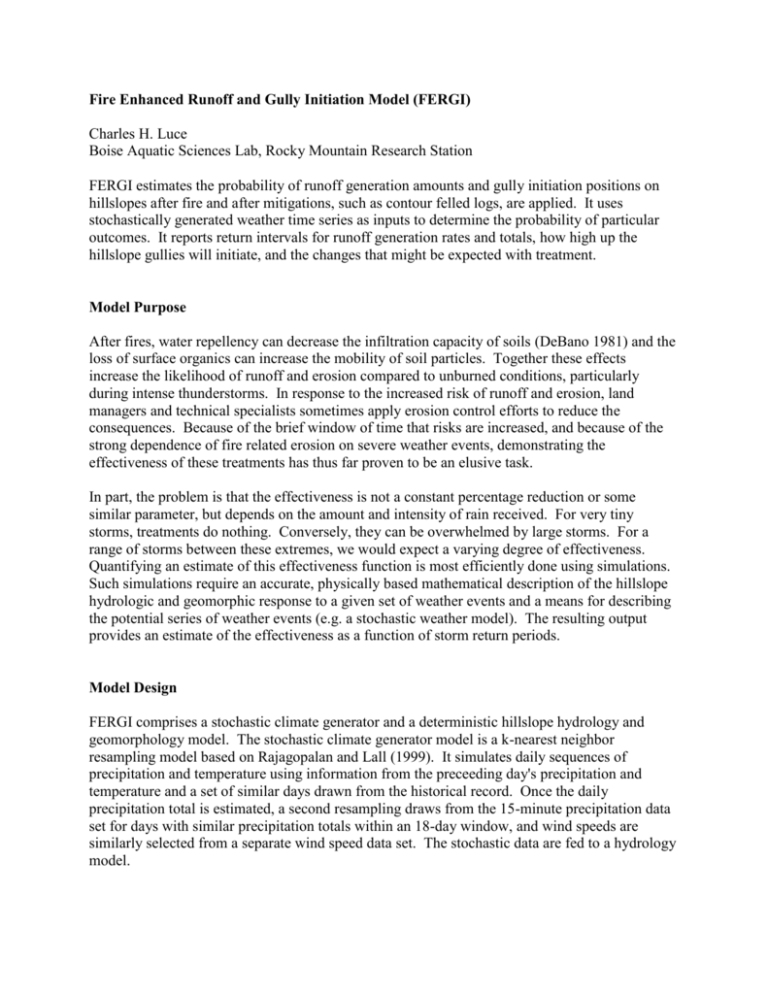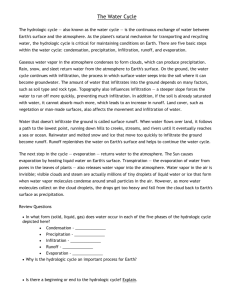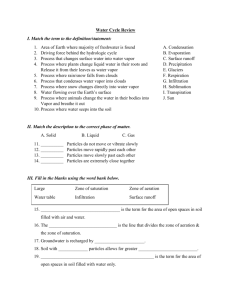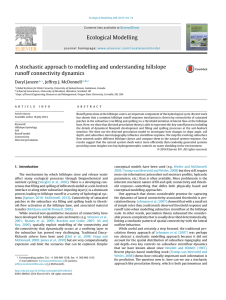Fire Enhanced Runoff and Gully Initiation Model
advertisement

Fire Enhanced Runoff and Gully Initiation Model (FERGI) Charles H. Luce Boise Aquatic Sciences Lab, Rocky Mountain Research Station FERGI estimates the probability of runoff generation amounts and gully initiation positions on hillslopes after fire and after mitigations, such as contour felled logs, are applied. It uses stochastically generated weather time series as inputs to determine the probability of particular outcomes. It reports return intervals for runoff generation rates and totals, how high up the hillslope gullies will initiate, and the changes that might be expected with treatment. Model Purpose After fires, water repellency can decrease the infiltration capacity of soils (DeBano 1981) and the loss of surface organics can increase the mobility of soil particles. Together these effects increase the likelihood of runoff and erosion compared to unburned conditions, particularly during intense thunderstorms. In response to the increased risk of runoff and erosion, land managers and technical specialists sometimes apply erosion control efforts to reduce the consequences. Because of the brief window of time that risks are increased, and because of the strong dependence of fire related erosion on severe weather events, demonstrating the effectiveness of these treatments has thus far proven to be an elusive task. In part, the problem is that the effectiveness is not a constant percentage reduction or some similar parameter, but depends on the amount and intensity of rain received. For very tiny storms, treatments do nothing. Conversely, they can be overwhelmed by large storms. For a range of storms between these extremes, we would expect a varying degree of effectiveness. Quantifying an estimate of this effectiveness function is most efficiently done using simulations. Such simulations require an accurate, physically based mathematical description of the hillslope hydrologic and geomorphic response to a given set of weather events and a means for describing the potential series of weather events (e.g. a stochastic weather model). The resulting output provides an estimate of the effectiveness as a function of storm return periods. Model Design FERGI comprises a stochastic climate generator and a deterministic hillslope hydrology and geomorphology model. The stochastic climate generator model is a k-nearest neighbor resampling model based on Rajagopalan and Lall (1999). It simulates daily sequences of precipitation and temperature using information from the preceeding day's precipitation and temperature and a set of similar days drawn from the historical record. Once the daily precipitation total is estimated, a second resampling draws from the 15-minute precipitation data set for days with similar precipitation totals within an 18-day window, and wind speeds are similarly selected from a separate wind speed data set. The stochastic data are fed to a hydrology model. Evaporation Dwr Precipitation Drainage Runoff Infiltration Figure 1: Schematic of the hillslope hydrology in FERGI. The water repellent layer that may form after fire is generally underneath a shallow layer (< 10 cm thick) of soil that is not water repellent (DeBano 1981). That layer is discontinuous, allowing water to penetrate through regions with lower repellency. FERGI calculates the water balance of the thin layer of soil overlying the water repellent layer of depth Dwr (Figure 1). The model shares its conceptual basis with a more conceptual approach proposed by Shakesby et al. (2000), but goes a step further in numerically estimating the components of the water balance given driving weather. The water balance of the thin layer is maintained with both short term and long term components (Figure 1). The long term components include drainage and evaporation that reduce the water content of the layer over days. Potential evaporation is based on daily climate simulation and modified by the water content of the surface layer. Drainage brings the surface water content to field capacity by the end of each day. The short term components are precipitation and infiltration that occur during brief precipitation events. Precipitation is provided by the stochastic climate generator as a series of intensities and durations. Infiltration capacity is estimated as the mineral soil saturated hydraulic conductivity multiplied by the fractional water repellent area. Contour felled logs add a component of surface storage and decrease the fractional water repellent area. Runoff is precipitation that is excess to infiltration and storage within the shallow layer. Runoff is routed using a kinematic wave approach to estimate the depth of flow as a function of contributing hillslope distance and, consequently, shear stress. The shear stress is compared to critical shear stress for initiation of particle motion to estimate where gullies might initiate during an event (Istanbulluoglu et al. 2002). Running the Model The user will be asked to supply some simple information for the model runs. The information will be related to climate and to soil/hillslope conditions. For the climate information, they will need to specify the climate stations to be used in the stochastic simulations. Conceptually we would like this to be done on a map interface, so that users can select stations that are near the site geographically and most similar to the site climatically in their judgment. Soil characteristics that will need to be estimated relate to median grain size, porosity, hydraulic conductivity, for which there are published relationships to soil texture. In addition, they will be asked to supply the fractional water repellency for the area, which can be measured or estimated, and the amount of surface water detention provided by treatments. Guidance will be provided for all inputs. Fractional Runoff Reduction 1 0.8 0.6 0.4 0.2 0 1 2 5 10 20 50 100 Recurrence Interval (years) Figure 2: Example result from FERGI showing runoff reduction from application of contour felled logs. Output from the model will be provided as tables that can be put into graph making programs such as Excel. The amount of runoff and location of potential gully initiation points will be key metrics. Status Currently FERGI is a set of programs run in sequence that require the user to obtain their own weather data. We can work with an ArcIMS screen and Java script on a web site to help users select the nearest weather stations and then ask them for site characteristics. This will make the program much easier to use and accessible to USDA and USDI specialists working on post-fire rehabilitation. References DeBano, L. F. 1981. Water repellent soils: a state-of-the-art. USDA Forest Service General Technical Report PSW-46, Pacific Southwest Research Station. Istanbulluoglu, E., D. G. Tarboton, R. T. Pack, and C. H. Luce. 2002. A probabilistic approach for channel initiation. Water Resources Research 38:1325, doi:1310.1029/2001WR000782. Rajagopalan, B., and U. Lall. 1999. A k–nearest-neighbor simulator for daily precipitation and other weather variables. Water Resources Research 35:3089-3101. Shakesby, R. A., S. H. Doerr, and R. P. D. Walsh. 2000. The erosional impact of soil hydrophobicity: current problems and future research directions. Journal of Hydrology 231-232:178-191.










